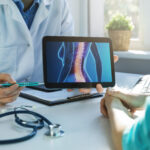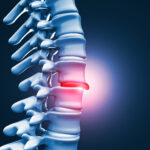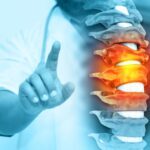
Degenerative Disc Disease
Diminished Cushioning and the Ripple Effect
The decrease in water content compromises the discs’ ability to function as effective cushions, placing greater stress on the annulus and resulting in further tears. The nucleus’s diminishing hydration causes it to collapse, causing the adjacent vertebrae to draw nearer. This reduction in disc space prompts the facet joints at the spine’s rear to shift, altering functionality and potentially triggering painful issues.
Around the disc space, bone spurs, or osteophytes, can begin to form. These spurs can also emerge around the facet joints, possibly as the body’s response to counter excessive motion at the spinal segment. While bone spurs can be harmless, they can become problematic if they encroach on the spinal canal, exerting pressure on the spinal cord and nerves. This condition is termed spinal stenosis.
Unveiling the Symptoms and Diagnosis
Among the initial indicators of degenerative disc disease is often back pain, which radiates to the buttocks and upper thighs. This condition encompasses a spectrum of spine issues that stem from disc damage and extend to various regions. Notable problems related to degenerative disc disease encompass discogenic pain and bulging discs.
Discogenic pain is the term employed by specialists to describe pain caused by damaged intervertebral discs. As the disc deteriorates, it might incite mechanical pain. Movements that stress the disc can trigger back pain that seemingly emanates from the disc itself. This kind of referred pain is comparable to other bodily injuries like broken bones or cuts. The pain manifests when you move the affected area.
Typically, discogenic pain centers in the lower back, potentially radiating to the buttocks and upper thighs. This radiation of pain or “referred pain” is a common occurrence not exclusive to the spine, as other conditions like gallstones or heart attacks can cause similar experiences of pain radiating to other parts of the body.


Treatment Paths for Degenerative Disc Disease
Treating degenerative disc disease is tailored to the condition’s severity. While some cases demand prompt attention, most do not necessitate surgery. Treatments can range from simple pain management and rest to more comprehensive strategies like physical therapy or epidural steroid injections. Collaborating with your doctor will ensure an appropriate and effective treatment plan, enabling you to navigate the journey of degenerative disc disease with confidence and relief.
Book an appointment
"*" indicates required fields










